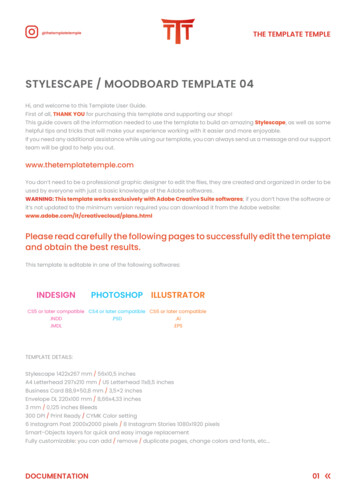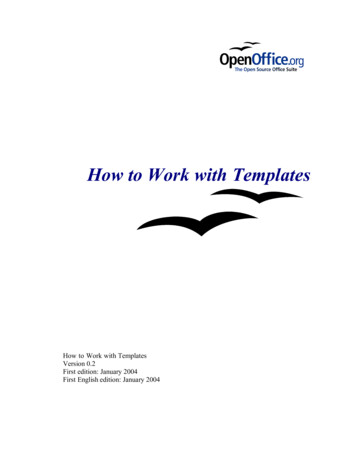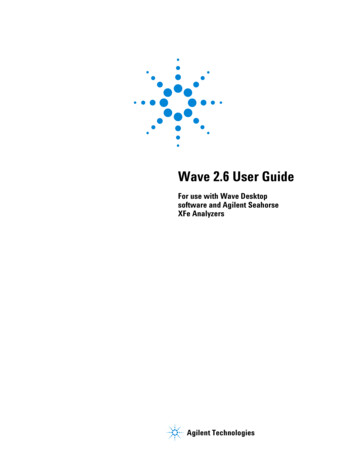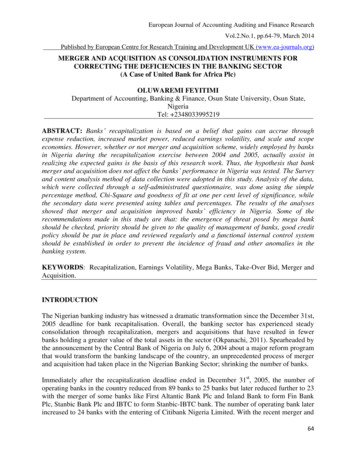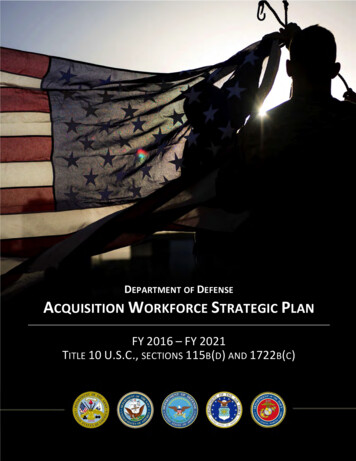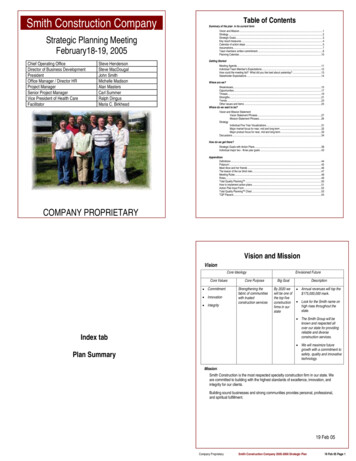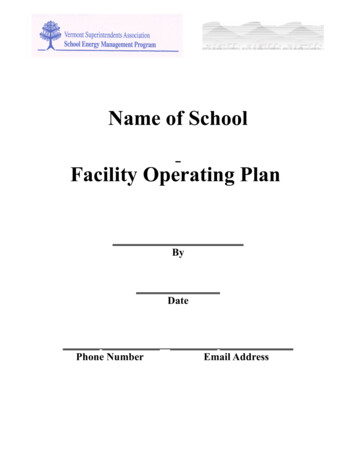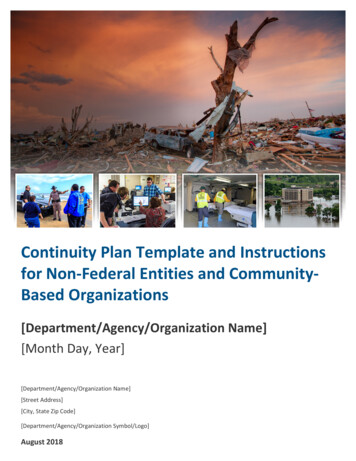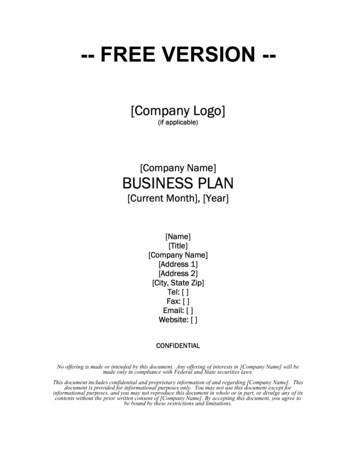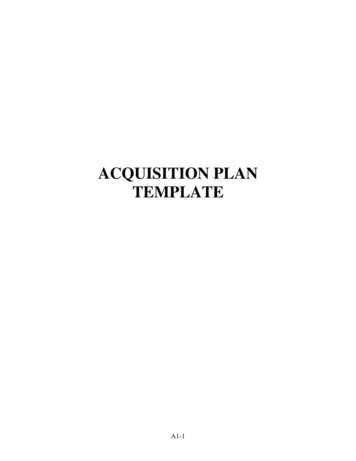
Transcription
ACQUISITION PLANTEMPLATEA1-1
APPENDIX A:SAMPLE ILLUSTRATED ACQUISITIONPLAN INCLUDINGFORMAT AND CONTENT
APPENDIX AACQUISITION PLAN SIGNATURE PAGE FORMAT(Classification: If not classified, must be FOR OFFICIAL USE ONLY.)ACQUISITION PLAN NUMBER: REV:PROGRAM TITLE: ACATACQUISITION PROGRAM MANAGER: CODECAPABILITIES/REQUIREMENTS DOCUMENT: Identify the capabilities (e.g., CapabilityDevelopment Document (CDD) or requirements (e.g., Operational Requirements Document(ORD) ) or other document that authorizes program initiation, include approval date, andrevalidation date, if applicable.ACQUISITION STRATEGY APPROVAL: Document approval of the Acquisition Strategy(AS).DESCRIPTION OF PROGRAM: Describe the program in brief, non-technical language; e.g.,a brief description similar to that forwarded in the Congressional Data Sheets with the annualbudget. Characterize the program's current phase/life-cycle status, e.g., entering SystemDevelopment and Demonstration Phase. Include item description, quantity being procured, andtime period. If the AP is being updated, provide the reason(s) for the update.APPROVED BY: HCA, PEO (include title)DateChief of Contracting OfficeDateContracting OfficerDateProgram ManagerDateQuestions concerning this AP should be referred to (name), (code), (telephone no.). The cutoffdate for information contained in this document is (date).
TABLE OF CONTENTS(Your Acquisition Plan Should Contain Information on Headings Listed Below)SECTION 1 ACQUISITION BACKGROUND AND OBJECTIVES1.11.21.31.41.51.6Statement of NeedHistorical SummaryApplicable ConditionsCapability or PerformanceDelivery or Performance-Period RequirementsIdentification of Participants in AcquisitionPlan PreparationSECTION 2 COST, BUDGET AND FUNDING otal Ownership CostDesign-to-CostApplication of Should-CostBudgeting and FundingBudgetFundingSECTION 3 ALTERNATIVES, TRADE-OFFS, AND RISKS3.13.23.3AlternativesTrade-OffsRisksSECTION 4 MILESTONES4.14.24.34.4Milestone Chart Depicting the Objectives of theAcquisitionMilestones for Updating the Acquisition PlanLogistics MilestonesApproval for Low-Rate Initial Production (LRIP) orFull Rate Production (FRP) (or Construction)SECTION 5 BUSINESS CONSIDERATIONS5.15.2Contractor vs. Government PerformanceWarrantyA-i
TABLE OF nment-Furnished PropertyGovernment-Furnished InformationAcquisition StreamliningSecurity ConsiderationsMake or BuyEnvironmental and Energy Conservation ObjectivesPriorities, Allocations and AllotmentsIndustrial PreparednessNational Technology and Industrial BaseLease or BuyOther ConsiderationsSECTION 6 TECHNICAL 56.4.66.4.76.4.86.4.9Test and EvaluationMetric System of MeasurementReliability, Maintainability, and Quality AssuranceAdditional Technical ConsiderationsSystems Safety ProgramStandard Electronic ModulesElectromagnetic Environmental EffectsFrequency Allocations and Frequency AssignmentsConfiguration ManagementEnvironmental Effects on PerformanceUnique Mapping, Charting, and Geodesy ProductsModular Open Systems Approach (MOSA)Quality and Information AssuranceSECTION 7 LOGISTICS CONSIDERATIONS7.17.27.37.47.57.6Contractor or Agency SupportStandardizationProduct/Technical DataComponent BreakoutSpare and Repair PartsTechnical DataA-ii
TABLE OF CONTENTSSECTION 88.18.28.38.48.58.68.78.88.98.108.11PLAN OF ACTION FOR EACH PROPOSED CONTRACTItem DescriptionEstimated CostSourcesCompetitionSource Selection ProceduresContracting ConsiderationsMilestones for the Acquisition CycleProduct or Services DescriptionsManagement Information RequirementsContract AdministrationOther ConsiderationsA-iii
APPENDIX ASECTION 1ACQUISITION BACKGROUND AND OBJECTIVES1.1FAR 7.105(a)(1)Introduce the acquisition by a brief statement of need. Includeany Acquisition Decision Memorandum (ADM), AcquisitionBoard (DAB), and/or internal service reviews.1.2FAR 7.105(a)(1)Statement of NeedHistorical SummarySummarize the technical and contractual history of the acquisition.Include, as appropriate:A brief statement indicating how long the program has been indevelopment and/or production and how long it is expected torun.A matrix of contracts awarded for the major end items for thepast five years, with contract number, contractor, contract type,nomenclature of item/service, quantities, and historical orestimated contract values. This should be presented in a brief,summary chart.The competition/sole source strategy for each major element ofprogram. If complex, include this information on the chart ormatrix mentioned above.Two or three brief sentences to add any further information onthe history of the program that you consider useful to reviewers.Do not use a multi-page, detailed history.1.3FAR 7.105(a)(2)State significant conditions affecting the acquisition, such as (i)requirements for compatibility with existing or future systems orprograms and (ii) any known cost, schedule, and capability orperformance constraints.1.4FAR 7.105(a)(4)Applicable ConditionsCapability or PerformanceSpecify the required capabilities or performance characteristics ofthe supplies or the performance standards of the services beingacquired and state how they are related to the need.
1.5FAR 7.105(a)(5)Delivery or Performance Period RequirementsDescribe the basis for establishing delivery or performance-periodrequirements (see FAR Subpart 11.4). For services acquisitions,indicate whether the contract will be for a term of performance ora completion date. Explain and provide reasons for any urgency ifit results in concurrency of development and production orconstitutes justification for not providing for full and opencompetition.Note: For example, timely delivery might be required in order for theGovernment to meet its obligations under another contract, or iftimely delivery or performance is unusually important to theGovernment, liquidated damages considerations might be required.1.6FAR 7.105(b)(21)Identification of Participants in Acquisition PlanPreparationList the individuals who participated in preparing the acquisitionplan, giving contact information and area of responsibility for each.A1-2
APPENDIX ASECTION 2COST, BUDGET AND FUNDING CONSIDERATIONS2.1FAR 7.105(a)(3)CostSet forth the established cost goals for the acquisition and therationale supporting them, and discuss related cost concepts to beemployed, including, as appropriate, the following items:2.1.1Total Ownership Cost (formerly called life-cycle cost)Not applicable to services acquisitions.FAR 7.105(a)(3)(i)Discuss how Total Ownership Cost (TOC) will be considered in allacquisitions of systems and/or equipment. If not used, explainwhy. If appropriate, discuss the cost model used to develop TOCestimates.Note: TOC includes all costs associated with research,development, procurement, operation, logistical support anddisposal of an individual weapon system including the totalsupporting infrastructure that plans, manages and executes thatweapon system program over its full life. TOC also includes thecost of requirements for common support items and systems thatare incurred because of introduction of that weapon system, butexcluding indirect “non-linked” infrastructure costs that are notaffected by individual weapon system’s development, introduction,deployment or operations. Software is also included.2.1.2Design-to-CostNot applicable to services acquisitions.FAR 7.105(a)(3)(ii)Describe the design-to-cost objective(s) and underlyingassumptions, including the rationale for quantity, learning-curve,and economic adjustment factors. Describe how objectives are tobe applied, tracked, and enforced. Indicate specific relatedsolicitation and contractual requirements to be imposed.Note: Design-to-cost principles should be applied: (1) in allmajor acquisition programs unless exempted. Design-to-costactivities are those undertaken to meet the cost objectives throughexplicit design activities. Cost as an Independent Variable (CAIV)depends on design-to-cost typeA2-2
activities to meet the objectives by instilling cost-consciousnessinto the designers, stimulating them to challenge requirements, andilluminating their cost progress.CAIV has refocused design-to-cost to consider cost objectives forthe total life cycle of the program and to view cost as anindependent variable with an understanding it may be necessary totrade-off performance to stay within cost objectives andconstraints.Under this concept, cost is a design constraint during the designand development phases and a management discipline throughoutthe acquisition and operation of the system or equipment.2.1.3Application of Should-CostNot applicable to service(s) procurementsFAR 7.105(a)(3)(iii)Describe the application of should-cost analysis to the acquisition(see FAR 15.407-4).Note: The objective of should-cost reviews is to promote shortand long-range improvements in the contractor’s economy andefficiency to reduce the cost of performance on Governmentcontracts. These reviews evaluate the economy and efficiency ofthe contractor’s existing work force, methods, materials, facilities,operating systems, and management. Should-cost reviews areaccomplished by a multi-functional team of Governmentcontracting, contract administration, pricing, audit, and engineeringrepresentatives.2.2Budgeting and FundingSee Appendix B for sample funding chart and follow the guidancein 2.2.1 and 2.2.2.2.2.1FAR 7.105(b)(5)BudgetInclude budget estimates, how they were derived, and discuss howadequate funds will be obtained as they are required (see FARSubpart 32.7).
Include specific reference to budget line items and programelements. Where applicable, estimated production unit cost, andthe total cost for remaining production.Briefly state how your budget estimates were developed. Shortnotes at the bottom of the funding chart (see Appendix B) may besufficient. It is important to describe the pricing methodology used(e.g., parametric, historical, bottom-up, catalogue, etc.).Discuss any Program Objectives Memorandum (POM)considerations that bear on the intended business strategy. If none,simply state that the funds represented in the funding chart areconsidered adequate to execute the stated strategy.2.2.2FundingIdentify available funding by appropriation and fiscal year.Identify total cost, contract cost, Other Government Activities(OGA) cost and quantities by appropriation, by year. If this is fora joint program, address the individual components quantities anddollars separately and then address the combined program.Identify applicable program element and project/task numbers forall funds. Identify the budget (e.g., "FY 06 President's Budget")represented by this matrix. Any elements of this matrix covered byother APs should merely reference those APs and show the dollarvalue covered in each other AP.A2-3
A2-4
SECTION 3ALTERNATIVES, TRADE-OFFS, AND RISKS3.1FAR 7.105(a)(1)AlternativesDiscuss feasible acquisition alternatives, the impact of prioracquisitions on those alternatives, and any related in-houseeffort. Describe the options in the Analysis of Alternatives(AOA) or Acquisition Decision Memorandum (ADM), anddelineate which option the acquisition plan supports.Where applicable, reference the approved AOA or ADM andapproval date.3.2FAR 7.105(a)(6)Trade-OffsDiscuss the expected consequences of trade-offs among thevarious cost, capability or performance, and schedule goals.Note: Cost/performance/schedule trade-offs should be shapingthe requirements and proposed design approaches on a costeffectiveness basis. Cost-effectiveness will be modified byaffordability considerations as the trade-offs start to focus onthe cost-effective alternatives that are practical from a budgetpoint-of-view. Cost As an Independent Variable should beutilized to make life-cycle affordability decisions. Costreductions should be accomplished through cost/performancetrade-off analyses, which should be conducted before anacquisition approach is finalized.3.3FAR 7.105(a)(7)RisksDiscuss technical, cost, and schedule risks and describe efforts,planned or underway, to reduce risk and the consequences offailure to achieve goals. If concurrent development andproduction is planned, discuss its effects on cost and schedulerisks.The acquisition strategy should identify the program risk areasand discuss how the PM intends to manage those risks. Discusscompliance and implementation of Production ReadinessReviews including major areas of technical risk. Describecorrective action planned or underway to reduce the risk ofbreaching performance, quality, cost and schedule thresholds.Provide a comparison of any recent test results with theestablished goals of the item or program.A3-1
A3-2
APPENDIX ASECTION 4MILESTONES4.1Milestone ChartInclude a milestone chart depicting the acquisition objectives. Asample milestone chart is provided in Appendix C.Include milestones for test events, preliminary design review(PDR), critical design review (CDR), production readiness review,contract award(s), option exercises, and for configuration/designfreeze and imposition of configuration control. In a concise noteon the chart, state whether formal configuration control is to beimposed, and if not, how configuration is to be managed.4.2Milestones for Updating the Acquisition PlanIndicate when the plan will be updated. Updates should bescheduled to coincide with MDA reviews and the transition fromone phase to another (e.g., Engineering and ManufacturingDevelopment to Production and Deployment).4.3Logistics MilestonesThis paragraph is not applicable to services acquisitions.FAR 7.105(b)(2)(iii)Identify key logistics milestones, such as technical data deliveryschedules and acquisition method coding conferences.4.4Approval for Low-Rate Initial Production (LRIP) orFull Rate Production (FRP)This paragraph is not applicable to services acquisitions.Indicate the date approval for low-rate initial production or full rateproduction has been or will be obtained. If waivers are requested,describe the need for the waivers.A4-1
A4-2
APPENDIX ASECTION 5BUSINESS CONSIDERATIONS5.1FAR 7.105(b)(8)Contractor Versus Government PerformanceAddress the consideration given to OMB Circular No. A-76 (seeFAR Subpart 7.3).Note: It is the policy of the Government to (i) rely generally onprivate commercial sources for supplies and services, if certaincriteria are met, while recognizing that some functions areinherently Governmental and must be performed by Governmentpersonnel, and (ii) give appropriate consideration to relative cost indeciding between Government performance and performanceunder contract. For further guidance, see OMB Circular A-76.FAR 7.105(b)(9)Inherently Governmental Functions. Address the consideration givento Office of Federal Procurement Policy Policy Letter 92-1,“Inherently Governmental Functions” (see FAR Subpart 7.5).5. 2FAR 7.105(b)(13)(ii)WarrantyDescribe any planned use of warranties (see FAR Subpart 46.7, forfurther guidance).Note: If appropriate, the program manager should incorporatewarranty requirements into major systems contracts in accordancewith FAR Subpart 46.7.5. 3FAR 7.105(b)(14)Government-Furnished PropertyIndicate whether property will be furnished to contractors,including material and facilities, and discuss any associatedconsiderations, such as its availability or the schedule for itsacquisition (see FAR Part 45).A5-1
5. 4FAR 7.105(b)(15)Indicate whether Government information, such as manuals,drawings and test data, will be provided to prospective offerors andcontractors.5. 5FAR 7.105(a)(8)Government-Furnished InformationAcquisition StreamliningDiscuss plans and procedures to (i) encourage industryparticipation by using draft solicitations, pre-solicitationconferences, and other means of stimulating industry involvementduring design and development in recommending the mostappropriate application and tailoring of contract requirements; (ii)select and tailor only the necessary and cost effectiverequirements; and (iii) state the timeframe for identifying which ofthose specifications and standards, originally provided forguidance only, shall become mandatory.Discuss acquisition streamlining as it relates to streamliningperformance requirements, the technical package, and the contractstrategy.Describe the market research efforts planned or undertaken toidentify non-developmental items (NDI).5. 6FAR 7.105(b)(17)Security ConsiderationsAcquisitions including classified matters must discuss howsecurity will be established, maintained, and monitored (see FARSubpart 4.4).5. 7Make or BuyThis paragraph is not applicable to services acquisitions.FAR 7.105(b)(11)Discuss considerations given to make-or-buy programs (see FARSubsection 15.407-2). The issues in USD(AT&L) memorandumof July 12, 2004, “Selection of Contractors for Subsystems andComponents,” should be addressed.A5-2
5. 8FAR 7.105(b)(16)Discuss applicable environmental and energy conservationobjectives associated with the acquisition (see FAR Part 23), theapplicability of an environmental assessment or environmentalimpact statement (see 40 CFR 1502), the proposed resolution ofenvironmental issues, and any environmentally-relatedrequirements to be included in solicitations and contracts.5. 9FAR 7.105(b)(7)Environmental and Energy Conservation ObjectivesPriorities, Allocations and AllotmentsWhen urgency of the requirement dictates a particularly shortdelivery or performance schedule, certain priorities may apply. Ifso, specify the method for obtaining and using priorities,allocations, and allotments, and the reasons for them (see FARSubpart 11.6). Identify the Defense Priority rating (DO/DX); e.g.,DO A3 for ships.5. 10Industrial Preparedness (if applicable)This paragraph is not applicable to services acquisitions.FAR 7.105(b)(19)Discuss the industrial preparedness program.Provide the program's industrial preparedness strategy that assessesthe capability of the U.S. industrial base to achieve identified surgeand mobilization goals. If no industrial preparedness strategy hasbeen developed, provide supporting rationale for this position.If in the industrial preparedness strategy, the development of adetailed industrial preparedness plan was determined to beapplicable, include the plan by text or reference. If thedevelopment of the industrial preparedness plan was determinednot to be applicable, summarize the details of this decision.A5-3
If the program involves peacetime and wartime hardwareconfigurations that are supported by logistics support plans,identify their impact on the industrial preparedness plan.5. 11National Technology and Industrial BaseFor major defense acquisition programs, address the following(P.L. 102-484, Section 4220):(1) Analysis of the capabilities of the national technology andindustrial base to develop, produce, maintain, and support suchprogram, including consideration of the following factors related toforeign dependency (P.L. 102-484, Section 4219(h):(i) The availability of essential raw materials, special alloys,composite materials, components, tooling, and production testequipment for the sustained production of systems fully capableof meeting the performance objectives established for thosesystems; the uninterrupted maintenance and repair of suchsystems; and the sustained operation of such systems.(ii) Identification of items specified in paragraph (1)(i)above that are available only from sources outside the nationaltechnology and industrial base.(iii) Availability of alternatives for obtaining such itemsfrom within the national technology and industrial base if suchitems become unavailable from sources outside the nationaltechnology industrial base; and an analysis of any militaryvulnerability that could result from the lack of reasonablealternatives.(iv) Effects on the national technology and industrial basethat result from foreign acquisition of firms in the United States.(2) Consideration of requirements for efficient manufacturingduring the design and production of the systems to be procuredunder the program.(3) Use of advanced manufacturing technology, processes, andsystems during the research and development phase and theproduction phase of the program.(4) Use of solicitation provisions to encourage, to the maximumextent practicable, competing offerors to acquire, for use in theperformance of the contract, modern technology, productionequipment, and production systems (including hardware andA5-4
software) that increase the productivity of the offerors and reducethe life-cycle costs.(5) Methods to encourage investment by U.S. domestic sources inadvanced manufacturing technology production equipment andprocesses through:(i) Recognition of the contractor’s investment in advancedmanufacturing technology production equipment, processes,and organization of work systems that build on workers’ skilland experience, and work force skill development in thedevelopment of the contract objective; and(ii) Increased emphasis in source selection on the efficiency ofproduction.(6) Expanded use of commercial manufacturing processes ratherthan processes specified by DoD.(7) Elimination of barriers to, and facilitation of, the integratedmanufacture of commercial items and items being produced undercontracts.(8) Expanded use of commercial items, commercial items withmodifications, or to the extent commercial items are not available,non-developmental items (see FAR 10).FAR 7.401(a) and5.12Lease vs. BuyIf the acquisition requires the lease of property for a period inexcess of 60 days, address lease vs. buy considerations.5. 13FAR 7.105(b)(19)Other ConsiderationsDiscuss, as applicable, the Defense Production Act, theOccupational Safety and Health Act, foreign sales implications,and any other matters germane to the plan not covered elsewhere.A5-5
A5-6
SECTION 6TECHNICAL CONSIDERATIONS6. 1FAR 7.105(b)(12)Test and EvaluationWhere applicable, describe the test program of the contractor andthe Government. Describe the test program for each major phaseof a major system acquisition. If concurrency is planned, discussthe extent of testing to be accomplished before production release.Provide Test and Evaluation Master Plan number and approvaldate. If not yet approved, provide approval status.6. 2FAR 7.103(m)Discuss use of the metric system of measurement in accordance with15 U.S.C. 205b (see FAR 11.002(b)). Each SYSCOM, PEO, andDRPM is responsible for administration of the metrication program.6. 3FAR 7.105(b)(13)(ii)Metric System of MeasurementReliability, Maintainability, and Quality AssuranceDescribe the program reliability, maintainability, and qualityassurance (RM&QA) requirements.When discussing R&M, address the mission profile, R&Mprogram plan, R&M predictions, redundancy, qualified parts list,parts and material qualification, R&M requirements imposed onvendors (subcontractors), failure analysis, corrective action andfeedback, and R&M design reviews and trade-off studies.6.4Quality and Information AssuranceDiscuss software development and documentation in accordancewith IEEE/EIA 12207. Discuss Software Acceptance Testing.Discuss the computer security requirement for the program. Statewhen the Computer Security Plan, Accreditation Plans, etc. havebeen or will be approved. State when accreditation was or will beobtained. Provide the name, code, telephone number, and e-mailaddress of the Computer Security Officer for the program.A6-4
APPENDIX ASECTION 7LOGISTICS CONSIDERATIONSThis Section is not applicable to services acquisitions.7.1Contractor or Agency SupportFAR 7.105(b)(13)(i)Describe the assumptions determining contractor or agencysupport, including consideration of contractor or agencymaintenance and servicing (see FAR Subpart 7.3) and distributionof commercial items, both initially and over the life of theacquisition.DFARS 207.105(b)Describe the extent of integrated logistic support (ILS) planning,including references to approved plans.Reference the ILS Plan and provide approval date. If not approved,provide approval status.7.2FAR 7.105(b)(13)(iv)StandardizationDescribe standardization concepts, including the necessity todesignate, in accordance with agency procedures, technicalequipment as "standard" so that future purchases of the equipmentcan be made from the same manufacturing source.7.3Digital Product/Technical Data and ProgramIntegrated Digital Environment (IDE)Describe the use of Digital Product/Technical Data as well asthe implementation of Integrated Digital Environment (IDE)(see Defense Acquisition Guidebook, Section 11.12, “IntegratedDigital Environment (IDE).”Note: Section 11.12, “Integrated Digital Environment (IDE) of theDefense Acquisition Guidebook provides that solicitations shouldA7-1
require IDE proposals to support system life cycle activities.Unless analysis verifies prohibitive cost or time delays, or apotential compromise of national security, new contracts shouldrequire the contractor to provide on-line access to programmaticand technical data. Contracts should give preference to on-lineaccess (versus data exchange) through a contractor informationservice or existing IT infrastructure. While contracts shouldminimally specify the required functionality and data standards,the data formats of independent standards-setting organizationsshould take precedence. The issue of data formats and transactionsets should be independent of the method of access or delivery.7.4FAR 7.105(b)(2)(ii)Identify major components or subsystems. Discuss componentbreakout plans relative to these major components or subsystems.Describe how competition for these components or subsystemswill be sought, promoted, and sustained.7.5FAR 7.105(b)(2)(iii)Spare and Repair PartsDescribe how competition for spares and repair parts will besought, promoted, and sustained.7.6FAR 7.105(b)(13)(iii)Component BreakoutTechnical DataDescribe the requirements for contractor data (includingrepurchase data) and data rights, their estimated cost, and theanticipated use of the technical data.Discuss the plan for acquiring and managing the acquisition oftechnical data, with particular emphasis on technical data packagesand technical manuals. The discussion should address:The overall program objectives, by program phase, for theacquisition of technical data, including the major types of datato be acquired and the uses to which they will be put. Discussthe results of cost effectiveness analyses related to thoseobjectives.Contractor use and certification of the technical data package(TDP).The planned methodology and schedule for conducting majortechnical data management events; e.g., validation/finalacceptance reviews, and identification of the product baselineconfiguration that the TDP describes.A7-2
Strategies for minimizing the amount of technical data deliveredto the government with other than unlimited rights.APs for follow-on procurements should address whether or not inprocess and final reviews of technical data, provided by theprevious contractor and intended to be provided to a follow-oncontractor, were made and the data determined to be adequate. Ifnot, explain why.A7-4
APPENDIX ASECTION 8PLAN OF ACTION FOR EACH PROPOSED CONTRACTNote: If more than one contract is anticipated, the Plan for each awardshould be presented in a separate sub-section (e.g., 8-A for the firstcontract, 8-B for the second contract, etc.). An index of the separateactions should be included at the beginning of Section 8 to identify theproposed contract actions. The Plan for each proposed contract actionshould address the following areas.8.1FAR 7.103(l)(2)Item DescriptionProvide a brief description of the item being procured under thecontract. A picture, drawing, diagram, or other graphicrepresentation may be included when necessary for adequatedescription.8.2Estimated CostProvide the estimated cost of the proposed acquisition. Identifyfunds by fiscal year and appropriation account. For acquisitionsthat contemplate the use of options or a multiple phased approach,separately identify the estimated cost for each option/phase. Forservices contracts, provide man-hours. If options are planned,provide man-hours for each option. Provide this estimated costdata in chart, matrix, or graphic form. Include quantities, or manhours for services, for all significant elements.Note: See Appendix D for a sample Estimated Cost chart.Address potential to acquire a higher quantity of an end item thanthe quantity specified in a law providing funding. For noncompetitive acquisitions, the acquisition of additional quantitiesmay not exceed 10% of the quantity approved in the justificationand approval.8.3FAR 7.105(b)(1)SourcesIdentify prospective sources of supplies and/or services that canmeet the need. Consider required sources of supplies and/orservices (see FAR Part 8). Include consideration of smallbusiness, HUBZone small business, small disadvantaged business,and women-owned small business concerns (see FAR Part 19), andthe impact of any consolidation or bundling that might affect theirparticipation in the acquisition (see FAR Section 7.107 (14 U.S.C.A8-1
644(e))). When the proposed acquisition strategy involvesbundling, identify the incumbent contractors and contracts affectedby the bundling. Address the extent and results of the marketresearch and indicate their impact on the various elements of theplan (see FAR Part 10).8.4FAR 7.105(b)(2)(i)CompetitionFull and Open Competition. Describe how competition will besought, promoted, and sustained throughout the course of theacquisition.Full and Open Competition After Exclusion of Sources. Ifexclusion of source(s) is proposed, identify the applicable statutoryauthority permitting exclusion. Cite the basis in FAR 6.202 or6.203 permitting the ex
delineate which option the acquisition plan supports. Where applicable, reference the approved AOA or ADM and approval date. 3.2 Trade-Offs FAR 7.105(a)(6) Discuss the expected consequences of trade-offs among the various cost, capability or performance, and schedule goals. Note: Cost/performance/schedule trade-offs should be shaping


